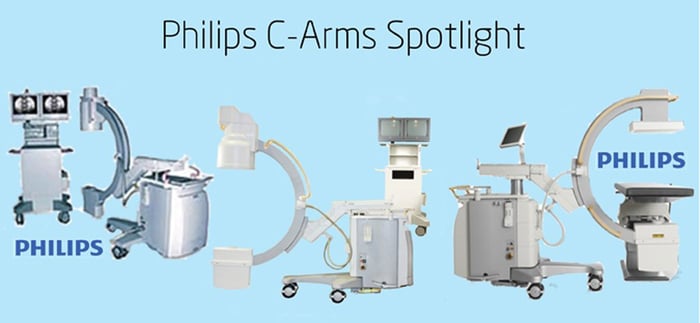The second part of our C-Arm spotlight series focuses on Philips. Philips has always played the role of little brother to GE OEC C-Arms. Philips C-Arms are great but generally not regarded as highly as the OECs. Philips missed an opportunity to take control of the C-Arm market when OEC was shut down by the FDA. OEC was able to stay the market leader of C-Arms even after having the work stoppage. Philips does very well specifically with Hospitals that buy only Philips equipment across all modalities. Philips is also ahead of OEC when it comes to flat panel detector C-Arms, but Philips does have stiff competition from the Siemens and Ziehm FD C-Arms.
Let's look at the Philips Catalog of C-Arms and take note of their current relevance:
BV 25 C-Arm: The BV 25 was a good C-Arm when it came out but is at end of life right now. Much like the OEC 9000, the BV 25 stayed relevant internationally but are too old now.
BV 29 C-Arm: The BV 29 was not all that different from the BV 25 other than that it came out a few years later. Much like its BV brother, the BV 29 is too old to be use domestically. There is still some international appeal to these C-Arms but even there it is limited.
BV 300 C-Arm: The BV 300 had the misfortune of being manufactured concurrently with the OEC 9600. Not a bad C-Arm but definitely overshadowed by the OEC 9600. But similar to most C-Arms manufactured in the mid 90s not called the OEC 9600, the BV 300 is approaching end of life. It can be sold domestically to a doctor with a very limited budget but there are other C-Arms that can be sold at the same price that are a better option. That said, there is still a lot of international interest in the BV 300.
Philips Pulsera C-Arm (Rev. 1 Software): The Pulsera was the C-Arm that really helped Philips gain a great reputation in the market. The BV 25, BV 29 and BV 300 were all solid C-Arms but the Pulsera broke the mold and gave Philips a great C-Arm. This C-Arm has a faster and more fluid operating system with better image quality. Being able to adjust the setting from a screen located on the C-Arm (as opposed to having to do it from the monitor cart) was the best improvement and really differentiated itself from OEC and the other C-Arm manufacturers. Being manufactured from 2000 - 2005, this version of the Philips Pulsera is a great alternative to the OEC 9600. It can be purchase right around the same price and is not as old as the OEC 9600. The biggest issue with the Pulsera (and all Philips C-Arms) is that there are proprietary restrictions on who can perform service work on their C-Arms. If there is an issue involving software, only a Philips engineer can work on the C-Arm. This leads to longer and more expensive service and has probably limited the success of the Pulsera on the resale market. Despite the servicing hurdle, the Philips Pulsera is still a great C-Arm to be purchased and used all across the country.
Philips Pulsera C-Arm (Rev. 2 Software): Philips had success with the original release of the Philips Pulsera, but when compared to the OEC 9800 it often came up short in the opinion of many doctors. That all changed in 2006. OEC was shut down by the FDA and in the same year, Philips released their modernized version of the Philips Pulsera. This version had a much more compact monitor cart, equipped with flat screen monitors that can fold in and were also height adjustable. There was also an option where the C-Arm could be customized and sold with a DVD Burner if the customer opted for it. It also had a much stronger generator having a max output of 15kW compared to the 7.5kW output of the Philips Pulsera C-Arm with R1 software. But maybe the most unique feature was that the C-Arm ran on Windows software. All C-Arms prior had a proprietary software owned by the equipment manufacturer. The Windows software enabled doctors to use a C-Arm that was not all the dissimilar to their personal computers. Philips did very well with this version of the Pulsera but the one hurdle they have not been able to leap was servicing. By still enforcing proprietary restrictions on the service work of their C-Arms, it continued to scare away a lot of buyers.
Philips Veradius C-Arm: Philips rolled with the Philips Pulsera R2 for years up until their release of the Philips Veradius in 2011. The future of C-Arms has Flat Panel Detectors instead of Image Intensifiers and Philips was smart to release a FD C-Arm as early as they did. The FD C-Arm allowed for higher resolution, consistent imagine quality without the images becoming grainy over time, and consistent clarity even in different magnification settings. The Veradius was also built with dose management settings to alleviate the concerns of excessive radiation on patients and X-Ray Technicians. Philips, along with Ziehm, were able to release a C-Arm before Siemens and OEC which helped them gain initial market share with FD C-Arms. The biggest problem with the Philips Veradius, and all FD C-Arms at the moment, is the price. With prices that exceed $200k, it has really limited the potential buyers for the Veradius, especially for the smaller clinics that are not a part of a larger hospital system. Since the initial release of the Philips Veradius, Siemens has come out with a very impressive line of FD C-Arms and OEC just announced that their version of a FD C-Arm is on the way.
Philips has continually played the role of little brother on the C-Arm market. Consistently having a very high quality C-Arm available, they always seemed to play second fiddle to OEC, even during the FDA work stoppage imposed on OEC C-Arms. It could have had something to do with the proprietary restrictions on servicing the C-Arms or maybe people just felt more comfortable with the OEC product line. Philips does have a few differentiators that buyers should consider when deciding on what C-Arm to buy. The most important of which might be price. When Philips C-Arms are resold, they are generally sold at a lower price than the OECs despite not being as old. The fact remains that when buying a C-Arm, there are a lot of great options out there. And Philips is definitely one of them.
Atlantis Worldwide is always here to help! Please contact us today!
Some blogs you may have missed:
- The ABC's of Purchasing C Arms
- 3 Siemens Arcadis C-Arms Compared: Varic, Avantic & Orbic
- How much does it cost to lease a C-Arm?
- Capture It All... with MediCapture
- Free C—Arm Resources
Meet the author: Alex Silbergleit




